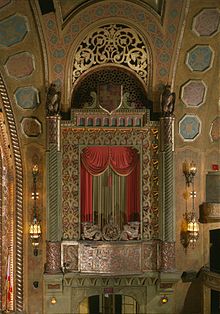 | |
| Address | 1817 Third Avenue North Birmingham, Alabama United States |
|---|---|
| Owner | Birmingham Landmarks, Inc. |
| Type | movie palace |
| Capacity | 2,176 |
| Current use | Performing arts center |
| Opened | December 26, 1927 (1927-12-26) |
| Website | |
| alabamatheatre | |
| Alabama Theatre | |
| U.S. National Register of Historic Places | |
| Alabama Register of Landmarks and Heritage | |
| Coordinates | 33°30′53.69″N 86°48′33.04″W / 33.5149139°N 86.8091778°W / 33.5149139; -86.8091778 |
| Area | 0.4 acres (0.16 ha) |
| Architect | Graven & Mayger |
| Architectural style | Mission/spanish Revival |
| NRHP reference No. | 79000386 |
| Significant dates | |
| Added to NRHP | November 13, 1979 |
| Designated ARLH | February 15, 1977 |
The Alabama Theatre is a movie palace in Birmingham, Alabama. It was built in 1927 by Paramount's Publix Theatres chain as its flagship theater for the southeastern region of the United States. Seating 2,500 people at the time, it was the largest in the Birmingham theater district. The district was once home to many large theaters and movie palaces that featured vaudeville, performing arts, nickelodeons and Hollywood films. Built to show silent films, the Alabama still features its original Wurlitzer theater organ. The Alabama Theatre and Lyric Theatre are the district's only remaining theaters, and as of 2024, both are in operation.
The Alabama and its historic organ were added to the Alabama Register of Landmarks and Heritage on February 15, 1977 and to the National Register of Historic Places on November 13, 1979. The theater has been surveyed by the Historic American Buildings Survey on several occasions, most recently in 1996. It was designated as the state's historic theater in 1993.
History
Construction plans for the Alabama Theatre were announced in 1926, but groundbreaking was delayed until April 1, 1927. The grand opening was held as originally scheduled on December 26, 1927. Construction of the concrete-and-steel building cost approximately $1.5 million.

In 1934, the adjacent Loveman's of Alabama department store was destroyed by fire. However, a thick firewall protected the theater and limited the impact to some smoke damage around air vents in the auditorium. The smoke stains would remain until the 1998 theater restoration.
In its early days, the Alabama Theatre hosted weekly Saturday meetings of the local chapter of Mickey Mouse Club, which was formed in 1933. By 1935, the club had more than 7,000 members, making it the world's largest Mickey Mouse Club. Membership eventually peaked at more than 18,000 before the club closed nearly ten years after it had been formed.
The Alabama Theatre hosted the Miss Birmingham pageant from 1935 to 1948 and the Miss Alabama pageant from 1949 until 1966.

The decline of downtown Birmingham through the 1960s and 1970s saw the closing of most of the downtown's movie theatres. In 1981, Plitt Theatres closed the Alabama and sold it to Cobb Theaters of Birmingham. Cobb unsuccessfully attempted to reopen the Alabama several times and eventually sold it to Costa and Head, developers working to revitalize the downtown area. Costa and Head initiated a series of classic films at the Alabama with some success, but ultimately filed for bankruptcy in 1986.
The Alabama chapter of the American Theatre Organ Society (ATOS) began maintaining the Alabama's organ in the 1970s. The group sought permission to remove the organ from the Alabama in order to save it, but Costa and Head's creditors deemed it the most valuable item in the building and forbade its removal. In response, the group began a fundraising effort to buy the theater, and it was purchased in 1987 by Birmingham Landmarks, Inc., a nonprofit organization originally started with the sole purpose of saving the theater. With the purchase, the theater was renamed the Alabama Theatre for the Performing Arts. In 1993, the Alabama was designated the official state historic theater of the state of Alabama.
In 1998, the Alabama Theatre underwent a complete restoration in which gold leaf and paint were cleaned or replaced, seats were replaced or recovered and some carpeting and drapes were replaced. The renovation coincided with the conversion of the 1935 Loveman's building into the McWane Science Center.
Birmingham Landmarks continues to own the theater, as well as the Lyric Theatre, a 1914 vaudeville theater located across the street from the Alabama, which reopened in 2016 after an $11.5 million restoration. The Alabama hosts approximately 250 events each year, attracting more than 400,000 people to a variety of performances including Broadway-type theatre, ballet, opera, concerts and film.
Organ

When the Alabama Theatre was built in 1927, films were silent and required musical accompaniment, typically provided by an orchestra or theater pipe organ. The Alabama's organ is a Crawford Special-Publix One Mighty Wurlitzer. Only 17 products of this model were built, and the Alabama's organ, nicknamed Big Bertha, is one of only three still installed at their original sites.
The Alabama's organ is a four-manual keyboard organ. It was originally installed with 20 ranks (sets of pipes) but has been expanded to 32. It also features numerous percussion instruments and sound effects to accompany silent films.
References
- ^ "National Register Information System". National Register of Historic Places. National Park Service. July 9, 2010.
- ^ "Properties on the Alabama Register of Landmarks & Heritage". Alabama Historical Commission. www.preserveala.org. Archived from the original on 4 September 2012. Retrieved 25 October 2012.
- ^ "Alabama Theatre, 1811 Third Avenue North, Birmingham, Jefferson, AL". Historic American Buildings Survey. Library of Congress.
- "Alabama Historic Theatre", Alabama Official Emblems, Symbols, and Honors, Alabama Department of Archives and History, February 6, 2014, archived from the original on 2008-04-15, retrieved 2019-05-08
- ^ Colurso, Mary (2016-01-13). "How was historic Lyric Theatre saved in Birmingham?". al. Retrieved 2023-12-12.
- ^ "Alabama Historic Theatre". Discover the Magic of the Alabama Brochure. Alabama Department of Archives and History. January 26, 2010. Archived from the original on January 13, 2019. Retrieved September 17, 2021.
External links
- Alabama Theatre (official website)
- Historic American Buildings Survey (HABS) No. AL-982, "Alabama Theatre, 1811 Third Avenue North, Birmingham, Jefferson County, AL", 106 photos, 20 color transparencies, 9 measured drawings, 36 data pages, 8 photo caption pages
- 1927 establishments in Alabama
- Theatres on the National Register of Historic Places in Alabama
- National Register of Historic Places in Birmingham, Alabama
- Cinemas and movie theaters in Alabama
- Buildings and structures in Birmingham, Alabama
- Theatres completed in 1927
- Properties on the Alabama Register of Landmarks and Heritage
- Mission Revival architecture in Alabama
- Spanish Colonial Revival architecture in Alabama
- Tourist attractions in Birmingham, Alabama
- Historic American Buildings Survey in Alabama
- Symbols of Alabama
- Movie palaces